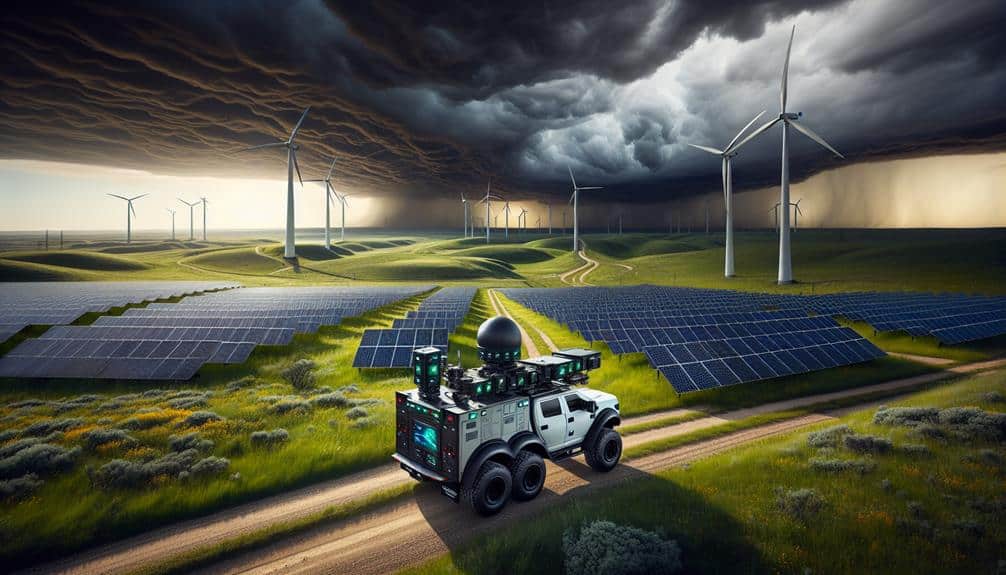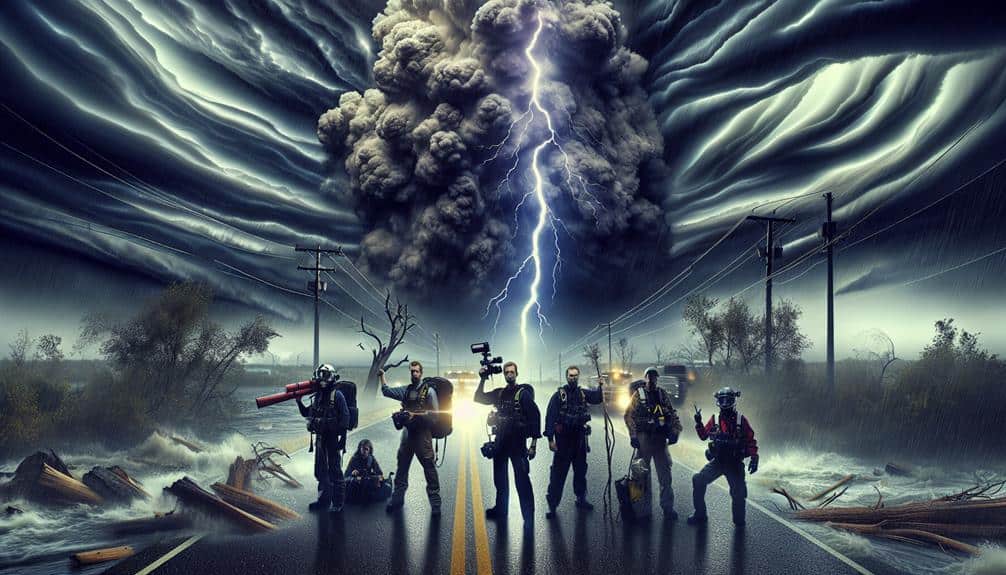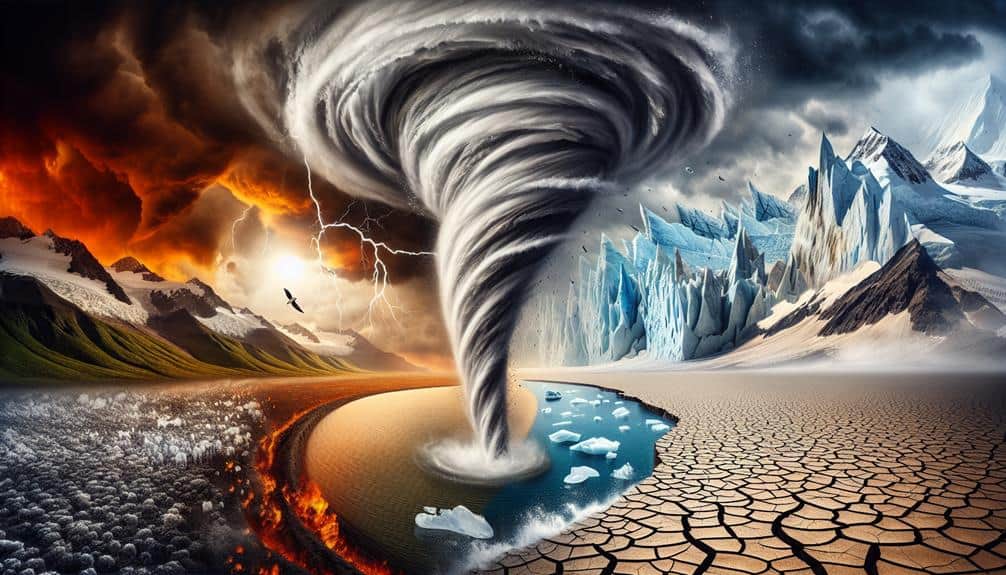We're leveraging cutting-edge storm-chasing technology to adapt to the intensifying climate-induced severe weather. Advanced radar systems like phased array and dual-polarization pinpoint storm trajectories with precision, while machine learning algorithms refine our predictive models. Enhanced data analytics allow for the interpretation of vast datasets, helping us forecast with unprecedented accuracy. Real-time communication tools guarantee seamless information flow, even in remote areas, enhancing safety and decision-making. We also prioritize sustainable practices, using renewable energy sources and eco-friendly vehicles. By integrating these technologies and methods, we're better equipped to tackle the challenges posed by our changing climate. Learn how these innovations are reshaping our approach.
Key Points
- Advanced radar systems with phased array and dual-polarization technologies enhance precise tracking and prediction of increasing storm intensities.
- Machine learning algorithms analyze historical and real-time data to improve storm forecasting accuracy.
- Real-time communication tools and satellite tracking ensure seamless information flow and safety for storm chasers.
- Sustainable chase practices, including the use of renewable energy and eco-friendly vehicles, reduce environmental impact.
Increased Storm Intensity
With climate change driving up sea surface temperatures, we're observing a significant rise in the intensity and frequency of severe storms. This shift presents us with both challenges and opportunities for climate adaptation.
According to the Intergovernmental Panel on Climate Change (IPCC), the increased thermal energy from warmer oceans is fueling more extreme weather events, including hurricanes and typhoons. These storms are now not only more frequent but also more powerful, with higher wind speeds and greater precipitation.
To adapt effectively, we need to leverage data-driven strategies that allow us to anticipate and respond to these changes. According to the National Oceanic and Atmospheric Administration (NOAA), there's been a 30% increase in Category 4 and 5 hurricanes over the past few decades. This trend underscores the urgency of developing climate adaptation technologies that can keep up with the evolving nature of extreme weather.
Advanced Radar Systems
In response to escalating storm severity, advanced radar systems have become indispensable tools in accurately tracking and predicting the behavior of these extreme weather events. By leveraging state-of-the-art radar precision, we can pinpoint storm formation, intensity, and trajectory with unparalleled exactness.
Our ability to predict storms is now more crucial than ever, as changing climates introduce new variables that challenge historical weather models.
Climate adaptation necessitates the integration of cutting-edge technology into our storm-chasing arsenal. Phased array radar systems and dual-polarization technologies have greatly enhanced our radar precision, enabling us to distinguish between types of precipitation and detect rotation within storm cells earlier than traditional radar systems.
This enhanced capability allows us to issue timely warnings and potentially save lives and property.
Moreover, technology integration extends beyond just hardware. We're incorporating machine learning algorithms to refine our storm prediction models continuously. These algorithms process vast amounts of radar data, identifying patterns that human analysts might overlook.
As we adapt to the evolving climate, our reliance on advanced radar systems and technological innovation ensures that we remain at the forefront of storm prediction, safeguarding our communities while embracing the freedom that comes from being prepared and informed.
Enhanced Data Analytics
Leveraging the precision of advanced radar systems, we now harness enhanced data analytics to interpret vast datasets and improve storm prediction accuracy. With the fusion of high-resolution radar data and machine learning algorithms, we can create predictive models that analyze and anticipate complex weather patterns. These models use historical and real-time data to forecast storms with unprecedented precision, giving us a powerful tool to stay ahead of nature's fury.
Data analytics allows us to process terabytes of information from multiple sources, including satellite imagery, ground sensors, and atmospheric readings. By integrating these data streams, we identify trends and anomalies that would be impossible to detect manually. Our predictive modeling capabilities enable us to simulate various scenarios, evaluating potential impacts and preparing accordingly.
Moreover, enhanced data analytics empowers us to refine our understanding of storm genesis and evolution. By continuously updating our models with fresh data, we adapt to changing climatic conditions and improve our predictive accuracy over time. This iterative process offers a dynamic approach to storm chasing, one that aligns with our desire for freedom and safety in an increasingly volatile environment.
Through these technological advancements, we're not just reacting to weather patterns; we're anticipating them.
Real-Time Communication Tools
Leveraging cutting-edge real-time communication tools, we guarantee seamless information flow among storm chasers, meteorologists, and emergency responders. Our system employs satellite tracking to monitor storm development with pinpoint precision. By integrating data from multiple sources, including Doppler radar and weather satellites, we can provide real-time updates on storm paths and intensity.
We've designed our communication network to be robust and resilient. Utilizing mesh networking technology, our devices maintain connectivity even in remote areas, ensuring that essential data reaches all stakeholders without delay. This is pivotal for issuing timely emergency alerts, which can save lives and mitigate property damage.
Furthermore, our satellite tracking capabilities allow us to monitor storm chasers' positions in real-time, providing an added layer of safety. By sharing this data with meteorologists and emergency responders, we can coordinate efforts more effectively, ensuring that everyone is on the same page.
This integrated approach not only enhances our understanding of storm behavior but also empowers individuals to make informed decisions, fostering a sense of freedom and control in the face of natural disasters.
Sustainable Chase Practices

Adopting sustainable chase practices, we prioritize minimizing environmental impact while maintaining high standards of data collection and safety. Integrating renewable energy sources into our operations is a pivotal step. We utilize portable solar panels and wind turbines to power our equipment on the go. These systems not only reduce our carbon footprint but also guarantee we've reliable, off-grid power in remote locations.
Our fleet now includes eco friendly vehicles designed to maximize fuel efficiency and minimize emissions. Electric and hybrid models are increasingly part of our lineup, leveraging advanced battery technology for extended range and durability. These vehicles are equipped with aerodynamic designs and regenerative braking systems to further improve energy efficiency.
We've also adopted rigorous protocols to limit waste and pollution. For instance, we use reusable materials for data logging and storage, reducing the need for disposable items. Our chase paths are meticulously planned using geographic information systems (GIS) to avoid sensitive ecosystems and reduce unnecessary travel.
Frequently Asked Questions
How Do Storm Chasers Ensure Their Safety During Extreme Weather Conditions?
Picture a lighthouse in a storm; we stay safe by using emergency shelters, reliable communication devices, and protective gear. We always have evacuation routes planned, ensuring we can retreat swiftly if the weather becomes too dangerous.
What Training Is Required to Become a Professional Storm Chaser?
To become professional storm chasers, we train in meteorology to understand weather patterns, and emergency response protocols to guarantee safety. This training includes data analysis, predictive modeling, and hands-on experience with advanced storm tracking technologies.
How Do Storm Chasers Contribute to Local Community Safety?
We save countless lives by providing real-time data for emergency preparedness. Our community outreach efforts educate and empower locals, ensuring they're always one step ahead of nature's fury. Together, we're the guardians against the storm's wrath.
Are There Any Legal Restrictions on Storm Chasing in Certain Areas?
Yes, there are legal restrictions on storm chasing in certain areas. Privacy concerns and drone usage regulations must be respected. Additionally, environmental impact assessments and data collection guidelines often dictate where and how we can operate.
What Kind of Vehicles Are Typically Used in Storm Chasing?
We typically use modified SUVs and trucks for storm chasing. These vehicles include specialized chasing equipment, advanced tracking technology, and robust communication systems. Vehicle modifications guarantee we can navigate rough terrains and maintain safety during extreme weather events.


